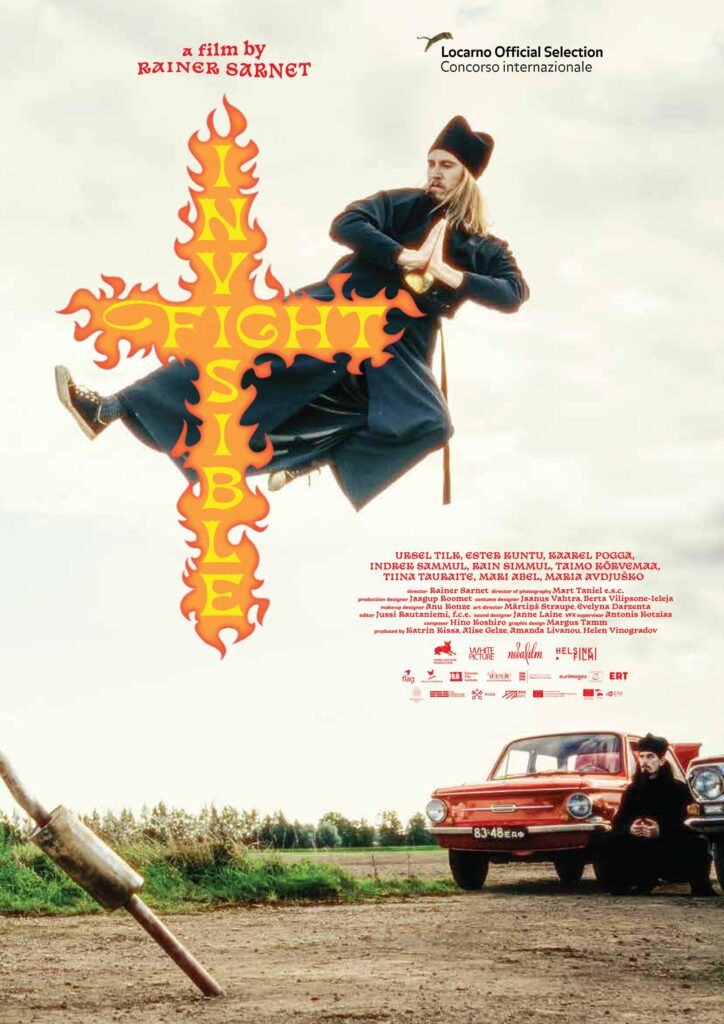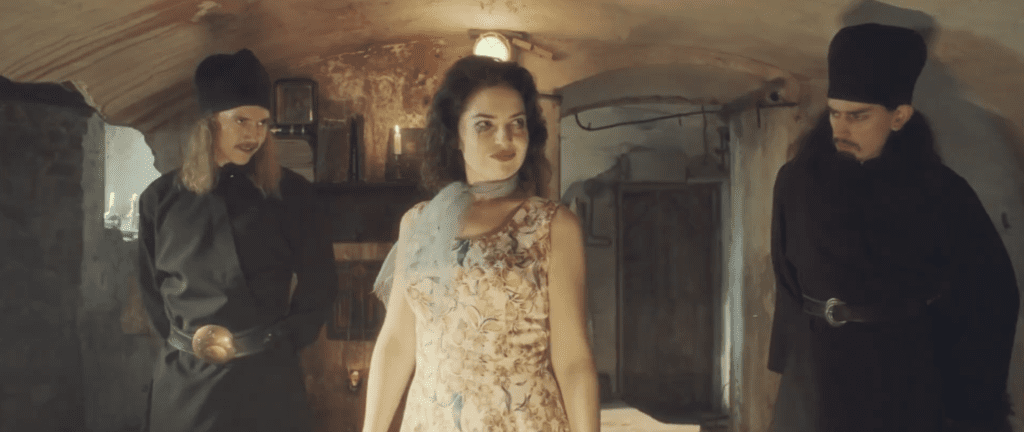
Watching Rainer Sarnet’s 2023 film The Invisible Fight (Nähtamatu võitlus) will have you pondering this at first. Along the way, though, once you loosen up and just accept the existence of an alternate reality, you will enjoy the film for its farcical spirit and the cinematic ramble through dedication and holiness.
The story begins with a young man, Rafael (Ursel Tilk), fulfilling his compulsory military service on the Russia-China border in 1973. While on guard, a trio of floating heavy metal kung fu assailants drops in, killing numerous Soviet troops and beating Rafael up, but with enough restraint that they can leave him a pair of nunchaku and set him out on a new path. As one officer says before croaking: “I guess God has other plans for you.”
It’s expected that this film would be a sharp comedy. Sarnet also directed November, the film adaptation of Andrus Kivirähk’s novel Rehepapp. November was deranged and mischievous in its chronicling of an old rural Estonian community. Now Sarnet has blended up action flick traditions with Soviet kitsch and poured it into the world of Orthodox mysticism — something he’s said to be passionate about.
Those initial two aspects simmer for a bit first, though. Back in Estonia, Rafael is determined to pursue martial arts and has picked up quite a few skills on his own. He trains to Black Sabbath’s “The Wizard” (a kind of leitmotif that keeps coming back) and walks around in leather and heeled boots, much to the frustration of his mother (Maria Avdjushko).
The problem is, Rafael’s interests are banned by the government. So he has to be discreet. He works for an auto mechanic by day and blows off steam partying at night. At one such party, he forms a short-lived bond with Rita (Ester Kuntu), who is soon to get married.
Father Nafanail (Indrek Sammul), a goofball starets (religious teacher)… transforms the cocky, blundering man into a perceptive, humble monk. At least, that’s what he tries to do.
Things pivot, however, when Rafael’s car conveniently breaks down by an Orthodox monastery, where monks train in kung fu. Rafael explains his wish to become “bad ass at black metal kung fu,” and though he is mocked at first, after a demonstration of powerful prayer, he is taken in by Father Nafanail (Indrek Sammul), a goofball starets (religious teacher) who transforms the cocky, blundering man into a perceptive, humble monk. At least, that’s what he tries to do.
Contrary to other martial arts movies, the protagonist doesn’t really have to learn much about fighting itself and for a while, he doesn’t become profoundly wiser either. Through religious and moral lessons, he only briefly swaps his joyful, adolescent attitude for a dour one. He’s accepted as a “chosen one” just as he is.
This enrages the serious Irinei (Kaarel Pogga), a colleague and supervisor of Rafael’s who has long sought to succeed Nafanail. This becomes a micro plot as much as a running joke. Sometimes our plans turn sour when we work too hard for them.
Rafael’s biggest struggles are facing his past existence in the context of his new occupation. His mother doesn’t want Rafael to leave home. Rita is in a suicidal state of mind, working at a monotonous bottle exchange job. The whole monastery is threatened after a run-in with a Soviet security agent. Rafael is tempted by vodka, sausage, and fast driving. The pull of the past is actually the thing that ends up changing him more than anything. The struggles, or demons, that make up the “invisible fight.” You’ll have to watch the film to see if everyone makes it and if Rafael gets what he was looking for all along.

On a technical and performance level, this movie is fun and would be a good choice for a movie night with friends. (Here’s a fun pop culture test for that movie night: see if you can identify the väliseesti song used during a scene where Rita comments on feminism and relationships.)
The cast did a terrific job of embodying their characters’ personalities. The recreation of a campy, lethargic Soviet society is well done. The reimagined movie and cartoon tropes — dexterously catching flying dumplings, severe pushup workouts, bouncy spring noises — get you giggling. And the pace and sequencing, with rapid cuts and numerous wire-flying fights, keep things moving.
Just like November looked at paganism sneaking around Catholicism, The Invisible Fight looks at Christianity keeping a low profile around state atheism.
But what ended up remaining after the film ended, after the jokes and punches subsided, was the humorous examination of belief in Estonian history. Just like November looked at paganism sneaking around Catholicism, The Invisible Fight looks at Christianity keeping a low profile around state atheism. It’s a gloomy subject really. And still, Rainer Sarnet brightens viewers’ moods.
In an interview with Tristan Priimägi, Sarnet said, “If my film were to carry any message, it would be an invitation to be more joyful.” When you think about Sarnet’s ability to make us laugh in a low place, and when you think about the enduring smile of the main character, those might just be the holiest things of all.
The Invisible Fight is available for rental on Apple TV and YouTube.



